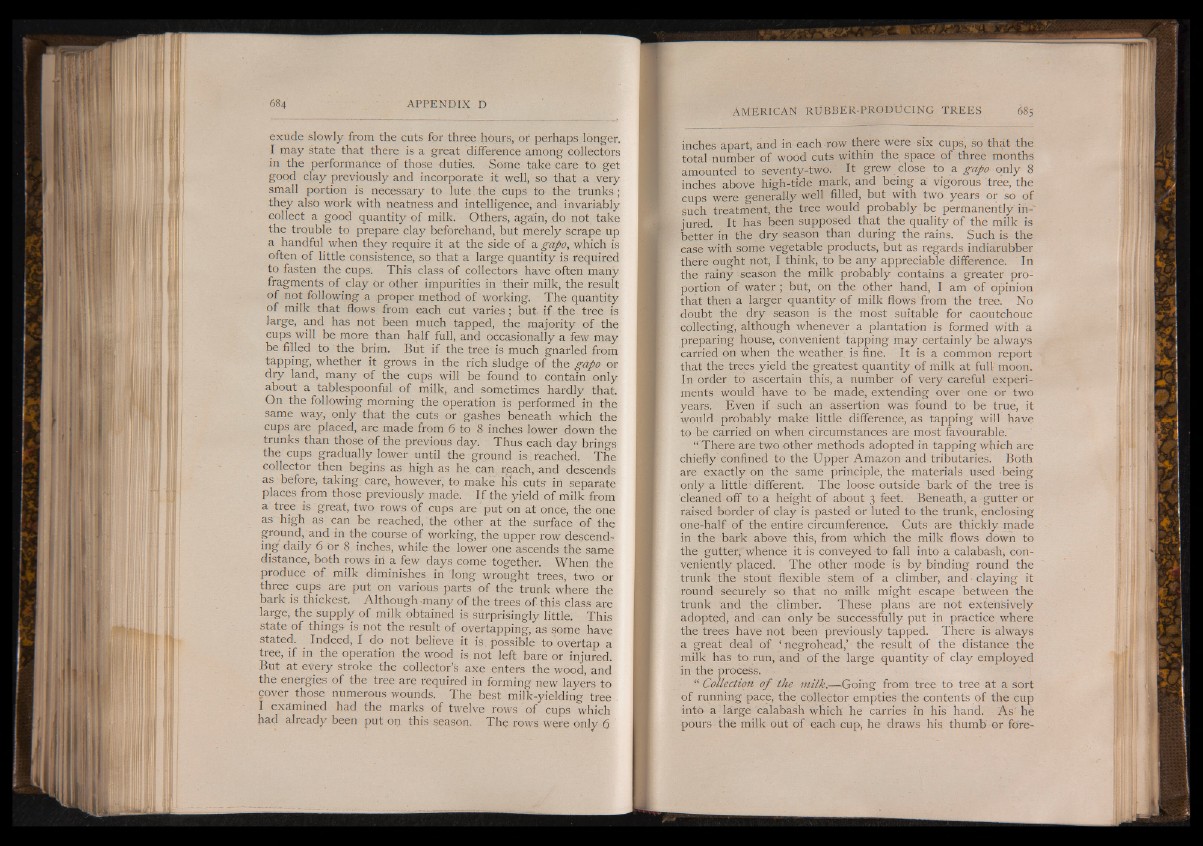
exude slowly from the cuts for three hours, of perhaps longer.
I may state that there is a great difference among collectors
in the performance of those duties. Some take care to get
good clay previously and incorporate it well, so that a very
small portion is necessary to lute.the cups to the trunks;
they also work with neatness and intelligence, and invariably
collect a good quantity of milk. Others, again, do not take
the trouble to prepare clay beforehand, but merely scrape up
a handful when they require it at the side of a gapo, which is
often of little consistence, so that a large quantity is required
to fasten the cups. This class of collectors have often many
fragments of clay or other impurities in their milk, the result
of not following a proper method of working. The quantity
of milk that flows from each cut varies; but. if the tree is
large, and has not been much tapped, the majority of the
cups will be more than half full, and occasionally a few may
be filled to the brim. But if the tree is much gnarled from
tapping, whether it grows in the rich sludge of the gapo or
dry land, many of the cups will be found to contain only
about a tablespoonful of milk, and sometimes hardly that.
On the following morning the operation is performed in the
same way, only that the cuts or gashes beneath which the
cups are placed, are made from 6 to 8 inches lower down the
trunks than those of the previous day. Thus each day brings
the cups gradually lower until the ground is ^reached. The
collector then begins as high as he can roach,-and descends
as before, taking care, however, to make his cuts’ in separate
places from those previously made. I f the yield of milk from
a tree is great, two rows of cups are put on at once, the one
as high as can be reached, the other at the surface of the
ground, and in the course of working, the upper row descending
daily 6 or 8 inches, while the lower one ascends the same
distance, both rows in a few days come together. When the
produce of milk diminishes in long wrought trees, two or
three cups are put on various parts of the trunk where the
bark is thickest Although -many of the trees of this class are
large, the supply of milk obtained is surprisingly little. This
state of things is not the result of overtapping, as some have
stated. Indeed, I do not believe it is possible to overtap a
tree, if in the operation the wood is not left bare or injured.
But at every stroke the collector’s axe enters the wood, and
the energies of the tree are required in forming new layers to
cover those numerous wounds. The best milk-yielding tree
I examined had the marks of twelve rows of cups which
had already been put on this season. The rows were only <5
inches apart, and in each row there were six cups, so that the
total number of wood cuts within the space of three months
amounted to seventy-two. It grew close to a gapo only 8
inches above high-tide mark, and being a vigorous tree, the
cups were generally well filled, but with two years or so of
such treatment, the tree would probably be permanently in-'
jured. It has been supposed that the quality of the milk is
better in the dry season than during the rains. Such is the
case with some vegetable products, but as regards indiarubber
there ought not, I think, to be any appreciable difference. In
the rainy season the milk probably contains a greater proportion
of water ; but, on the other hand, I am of opinion
that then a larger quantity of milk flows from the tree. No
doubt thé dry season is the most suitable for caoutchouc
collecting, although whenever a plantation is formed with a
preparing house, convenient tapping may certainly be always
carried on when the weather is fine. It is a common report
that the trees yield the greatest quantity of milk at full- moon.
In order to ascertain this, a number of very careful experiments
would have to be made, extending over one or two
years. Even if such an assertion was found to be true, it
would probably make little difference, as tapping will have
to be carried on when circumstances are most favourable.
“ There are two other methods adopted in tapping which are
chiefly confined to the Upper Amazon and tributaries. Both
are exactly on the same principle, the materials used being
only a little-different. The loose outside bark of the tree is
cleaned off to a height of about 3 feet. Beneath, a gutter or
raised border of clay is pasted or luted to the trunk, enclosing
one-half of the entire circumference. Cuts are thickly made
in the bark above this, from which the milk flows down to
the gutter, whence it -is conveyed to fall into a calabash, conveniently
placed. The other mode is by binding round the
trunk the stout flexible stem of a climber, and ■ claying it
round securely so that no milk might escape between the
trunk and the climber. These plans are not extensively
adopted, and can only be successfully put in practice where
the trees have not been previously tapped. There is always
a great deal of ‘ negrohead,’ the result of the distance the
milk has to run, and of the large quantity of clay employed
in the process. - •
“ Collection o f the milk.—-Going from tree to tree at a sort
of running pace, the collector empties the contents of the cup
into a lârge calabash which he carries in his hand. A s 'h e
pours the milk out of each cup, he draws his thumb or fore